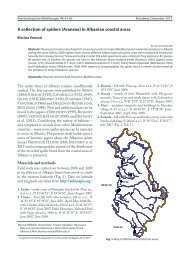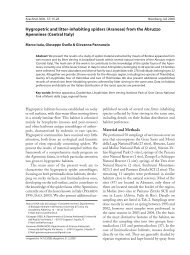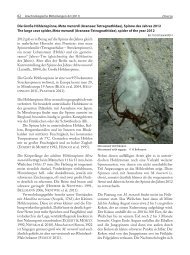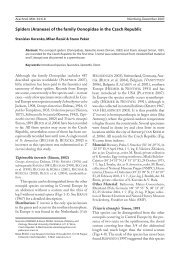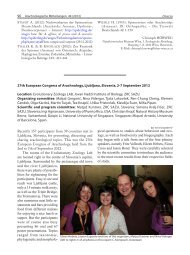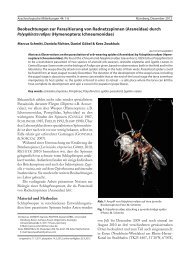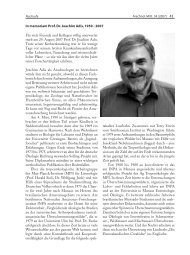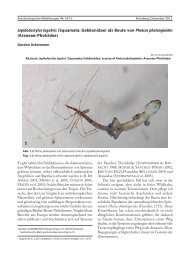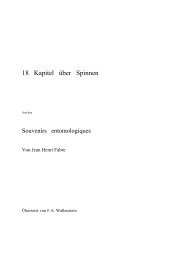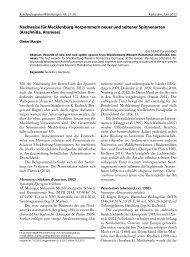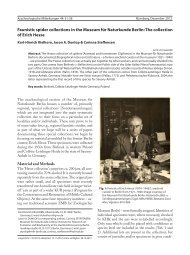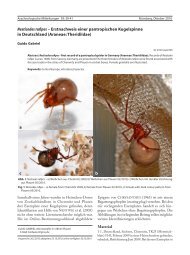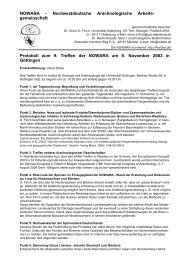download PDF - Arachnologische Gesellschaft e.V.
download PDF - Arachnologische Gesellschaft e.V.
download PDF - Arachnologische Gesellschaft e.V.
You also want an ePaper? Increase the reach of your titles
YUMPU automatically turns print PDFs into web optimized ePapers that Google loves.
The whip spider collection in the Vienna museum 49Fig. 3: Female of Charinus ioanniticus (Rhodes, found in subterranean passages of the ancient city of Rhodes and photographed alivein a standard plastic terrarium by M. Seiter)List of abbreviations: BMNH: British Museum(Natural History) in London, NHMW: NaturalHistory Museum Vienna, sp.: species, leg. = legit(collected), det. = determinavit (determined), don. =(donated), ) = male / ( = female, )) = males / ((= females, HT = Holotype, LT = Lectotype, ST =SyntypeResultsThe oldest parts of the Arachnoidea collection itselfmay date back to the early 19 th century; the oldestAmblypygi dates from 1871 (see Fig. 1). The curatorsresponsible for the collection of arachnids, starting in1878, were Carl Koelbel, Theodor Adensamer, ArnoldPenther, Carl Attems, Otto Pesta, Eduard Reimoser,Hans Strouhal, Gerhard Pretzmann, JürgenGruber, Verena Stagl (for the collection history seePesta 1940) and, today, the second author of this paper:Christoph Hörweg.For whip spiders, relevant collectors/donators informer times were Theodor Adensamer, DominikBilimek and Eduard Reimoser (see Pesta 1940),and more recently Helmut Sattmann. Most of thematerial originated from Sri Lanka (as Ceylon),Mexico, Rhodes (Greece) and Oman. The specimensin the collection were formerly revised byQuintero in 1980 and Weygoldt in 1996 and 1998.Today, the whip spider collection holds a total of167 specimens, including 27 species in 10 generaand 4 families (Tab. 1). It includes types of 4 species.Supplementary information about these species willbe given below.Type specimensCharinidae Quintero, 1986Charinus ioanniticus (Kritscher, 1959) (syntypes)= Lindosiella ioannitica Kritscher, 1959 (syn. by Weygoldt1972)
The whip spider collection in the Vienna museum 51live in subterranean passages of the ancient city ofRhodes (a cave-like lifestyle) (Weygoldt 2005). Thisform of reproduction is very rare in whip spiders. Itis known only in Charinus acosta (Quintero, 1983)(de Armas 2000, 2005) from Cuba. C. ioanniticus hasalso been reported from Turkey (Kovařík & Vlasta1996, Weygoldt 2005, Seyyar & Demir 2007), Israel(Rosin & Shulov 1960) and Egypt (El-Hennawy2002), but these populations all reproduce sexually.Phrynichidae Simon, 1892Damon brachialis Weygoldt, 1999 (holotype)This species was described by Weygoldt (1999) in his revisionof the genus Damon.Location: Mozambique. Surroundings of Boroma,“Afrika: Zambese”, from the late 19 th century, leg. P. Menyhardt,don. Dr. Karl Brancsik, det. Peter WeygoldtInventory number: NHMW 1440, 1) (= HT)Remarks: This specimen was initially determined (mostlikely by Kraepelin) as Damon variegatus (Perty, 1834) (seeFig. 2).Phrynidae Blanchard, 1852Phrynus parvulus (Pocock, 1902) (lectotype)= Tarantula marginemaculata yucatanensis Werner, 1902 (syn.by Quintero 1981)This specimen was revised and synonymised by Quintero(1981) in his overview of the amblypygid genus Phrynus inthe Americas.Location: Belize. Jukatan, 1902, leg. Schmarda &WernerInventory number: NHMW 1448, 1) (LT)Remarks: Quintero (1981) mentions two male holotypes,one of Phrynus parvulus (Pocock 1902), with type localityin Tikal, Guatemala (specimen examined from BMNH),and this particular specimen from the NHMW, with typelocality in Belize.We consider this specimen as lectotype by inference of holotypeby Quintero (1981), according to ICZN Art. 74.6.Paraphrynus mexicanus (Bilimek, 1867) (syntypes)= Phrynus mexicanus Bilimek, 1867 (transferred afterMullinex 1975)= Phrynus cacahuamilpensis Herrera, 1892 (syn. by GarciaAcosta 1977)These specimens were described by Bilimek (1867) asPhrynus mexicanus.Location: In the cave Cacahuamilpa in Mexico sitting onrocks, 14.1.1866, leg. Bilimek, det. Kraepelin.Inventory number: NHMW 1446, 2mm (ST)Remarks: Another juvenile specimen was found several dayslater at the same locality (NHMW 1447). In the originaldescription, however, only two adult males are mentioned.Checklist of the collectionThe complete species list of the Amblypygi collectionat the NHMW is summarized in Tab. 1.ConclusionsThe whip spider collection of the NHMW – with167 specimens from 27 species – is considered to bea small one. Nonetheless, approx. 15% of the validspecies of the world are deposited in the museum,and the collection has types of 4 species.Note that the whip spider Charinus ioanniticusmade it – as “object No. 59”, titled “European Premiere”– into the book Top 100 of the NHMW (Ottet al. 2012). It states: “As until the middle of the 20 thcentury there was no indication that this group ofspiders existed at all in Europe. When arachnologistErich Kritscher discovered this sample of a new specieshiding in a crack in the wall at the Castle of theKnights of St. John in Lindos in 1959, it was trulysensational news”. Interesting is also the commenton one (juvenile) specimen of Charinus ioanniticus(NHMW 1939) which was found dead in the spidernet of Pholcus sp. (“von Pholcus gefesselt”).We would also like to point out one fact that cancause taxonomic problems, using Trichodamon princepsMello-Leitão, 1935 (NHMW 21842) as an example:The right basitibia of leg IV is not divided, butit is a principal character of this genus that it shouldbe divided. All other morphological characters (twosmall tubercles above the cleaning organ on pedipalpdistitarsus, ventral tibial spine I not bifid, etc.) arecorrect. This ‘non-divided’ part is caused by a formerlybroken leg which was regenerated over severalmolts. As this is not uncommon in Amblypygi, it isworth mentioning here.Note that many of the species mentioned hereare being captive bred and are available for scientificresearch – see Appendix. Contact the first author forfurther information.AcknowledgmentsWe would like to thank Jürgen Gruber for important informationabout the history of the collection and AmbrosHänggi and an anonymous reviewer for their valuableremarks to improve the manuscript.
52 M. Seiter & C. HörwegReferencesArmas LF de 2000 Parthenogenesis in Amblypygi (Arachnida).– Avicennia 12/13: 133-134Armas LF de 2005 Notas sobre la biología reproductiva desamblypygido partenogenético Charinus acosta (Quintero,1983) (Amblypygi: Charinidae). – Boletin de la SociedadEntomológica Aragonesa 36: 271-273Armas LF de 2012 Nueva especie de Paraphrynus Moreno,1940 (Amblypygi: Phrynidae) de México y el suroestede los EE.UU. de América. – Revista Ibérica de Aracnología21: 27-32Armas LF de & Teruel R 2010 Nueva escpecie de PhrynusLamarck, 1801 (Amblypygi: Phrynidae) de Puerto Rico.– Boletín de la Sociedad Entomológica Aragonesa 47:127-130Bilimek D 1867 Fauna der Grotte Cacahuamilpa in Mexico.– Verhandlungen der Zoologisch-Botanischen<strong>Gesellschaft</strong> in Wien 17: 905-906Blick T & Harvey MS 2011 Worldwide catalogues andspecies numbers of the arachnid orders (Arachnida). –<strong>Arachnologische</strong> Mitteilungen 41: 41-43 – doi: 10.5431/aramit4108El-Hennawy HK 2002 The first record of Amblypygi fromEgypt. – Journal of Arachnology 30: 452-453 – doi:10.1636/0161-8202(2002)030[0452:TFROAF]2.0.CO;2Garcia Acosta R 1977 Révision de los Amblipigidos deMéxico (Arachnida: Amblypygi). Tesis, Instituto deBiología, Universidad Nacional Autonoma de Mexico,Mexico, D.F. 55 pp.Giupponi APL & Miranda GS 2012 A new species ofSarax Simon, 1892 from the Philippines (Arachnida:Amblypygi: Charinidae). – Anais da Academia Brasileirade Ciências 84:165-173 – doi: 10.1590/S0001-37652012000100017Harvey MS 2003 Catalogue of the smaller arachnid orders ofthe world: Amblypygi, Uropygi, Schizomida, Palpigradi,Ricinulei and Solifugae. CSIRO Publishing Huntingdon,Collingwood (Victoria, Australia). 385 pp.Harvey MS 2007 The smaller arachnid orders: diversity,descriptions and distributions from Linnaeus to thepresent (1758 to 2007). In: Zhang Z-Q & Shear WA(Eds.) Linnaeus tercentenary: progress in invertebratetaxonomy. – Zootaxa 1668: 363-380Harvey MS 2013 Whip spiders of the World, version 1.0.Western Australian Museum, Perth. – Internet: http://museum.wa.gov.au/catalogues-beta/whip-spiders [accessedat 24 October 2013]Harvey MS & West PLJ 1998 New species of Charon(Amblypygi: Charontidae) from Northern Australia andChristmas Island. – Journal of Arachnology 26: 273-284Kovařík F & Vlasta D 1996 First report of Amblypygi(Charinidae: Charinus ioanniticus) from Turkey. – Klapalekiana32: 57-58Kraepelin K 1895 Revision der Tarantuliden Fabr. (= PhrynidenLatr.). – Abhandlungen des naturwissenschaftlichenVereins Hamburg 13: 1-53Kritscher E 1959 Ergebnisse der von Dr. O. Paget und Dr.E. Kritscher auf Rhodos durchgeführten zoologischenExkursionen, II Pedipalpi (Amblypygi). – Annalen desNaturhistorischen Museums Wien 63: 453-457Mullinex CL 1975 Revision of Paraphrynus Moreno(Amblypygida, Phrynidae) for North America and theAntilles. – Occasional Papers of the California Academyof Sciences 116: 1-80Ott I, Schmid B, Köberl C & Golebiowski R 2012 NHM Top100. English Edition. Edition Lammerhuber und Verlagdes Naturhistorischen Museums, Baden & Wien. 231 pp.Pesta O 1940 Eduard Reimoser: Nachruf. – Annalen desNaturhistorischen Museums in Wien 51: 4-7Prendini L 2011 Order Amblypygi Thorell, 1883. In: ZhangZ-Q (Ed.) Animal biodiversity: an outline of higher-levelclassification and survey of taxonomic richness. – Zootaxa3148: 154Quintero D Jr 1981 The amblypygid genus Phrynus in theAmericas (Amblypygi, Phrynidae). – Journal of Arachnology9: 117-166Rahmadi C, Harvey MS & Kojima J-I 2010 Whip spidersof the genus Sarax Simon 1892 (Amblypygi: Charinidae)from Borneo Island. – Zootaxa 2612: 1-21Rahmadi C, Harvey MS & Kojima J-I 2011 The statusof the whip spider subgenus Neocharon (Amblypygi:Charontidae) and the distribution of the genera Charonand Stygophrynus. – Journal of Arachnology 39: 223-229– doi: 10.1636/CA10-77.1Rosin R & Shulov A 1960 Representatives of the orderAmblypygi (Arachnida) found in Israel. – Bulletin ofthe Research Council of Israel 9B: 167-168Seiter M 2011 Die Welt der Geißelspinnen (Arachnida,Amblypygi). Teil I: Einführung, Systematik & Phylogenie.– Arachne 16 (2): 28-37Seyyar O & Demir H 2007 A new locality for Charinusioanniticus (Kritscher, 1959) (Amblypygi: Charnidae).– Serket 10: 109-111Weygoldt P 1972 Charontidae (Amblypygi) aus Brasilien.Beschreibung von zwei neuen Charinus-Arten, mitAnmerkungen zur Entwicklung, Morphologie undTiergeographie und mit einem Bestimmungsschlüsselfür die Gattung Charinus. – Zoologische Jahrbücher,Abteilung für Systematik, Ökologie und Geographieder Tiere 99: 107-132Weygoldt P 1999 Revision of the genus Damon C.L. Koch,1850 (Chelicerata: Amblypygi: Phrynichidae). – Zoologica150: 1-45Weygoldt P 2000 Whip spiders: their biology, morphologyand systematics. Apollo Books, Stenstrup. 164 pp.Weygoldt P 2002 Sperm transfer and spermatophoremorphology of the whip spiders Sarax buxtoni, S. brachydactylus(Charinidae), Charon cf. grayi, and Stygophrynusbrevispina nov. spec. (Charontidae) (Chelicerata, Amblypygi).– Zoologischer Anzeiger 241: 131-148 – doi:10.1078/S0044-5231(04)70069-8Weygoldt P 2005 Biogeography, systematic position, andreproduction of Charinus ioanniticus (Kritscher 1959),
The whip spider collection in the Vienna museum 53with the description of a new species from Pakistan(Chelicerata, Amblypygi, Charinidae). – Senckenbergianabiologica 85: 43-56Weygoldt P 2007 Parthenogenesis and reproduction inCharinus ioanniticus (Kritscher, 1959) (Chelicerata,Amblypygi, Charinidae). – Bulletin of the British arachnologicalSociety 14: 81-82AppendixChecklist of the personal collection of Michael Seiter(as of 21.09.2013)* means that from this species, individuals from morethan one locality are availableCharontidae (1)Charon cf. grayi (Gervais, 1842)*Phrynichidae (12)Damon annulatipes (Wood, 1869)Damon diadema (Simon, 1876)Damon medius (Herbst, 1797)*Damon tibialis (Simon, 1876)Damon variegatus (Perty, 1834)Euphrynichus amanica (Werner, 1916)Euphrynichus bacillifer (Gerstaecker, 1873)Phrynichus ceylonicus (C.L. Koch, 1843)Phrynichus deflersi arabicus Simon, 1887Phrynichus exophthalmus Whittick, 1940Phrynichus jayakari Pocock, 1894Phrynichus orientalis Weygoldt, 1998Phrynidae (30)Acanthophrynus coronatus (Butler, 1873)Heterophrynus batesii (Butler, 1873)Heterophrynus cf. elaphus Pocock, 1903Paraphrynus aztecus (Pocock, 1894)Paraphrynus carolynae Armas, 2012Paraphrynus cubensis (Quintero, 1983)*Paraphrynus emaciatus Mullinex, 1975Paraphrynus laevifrons (Pocock, 1894)Paraphrynus mexicanus (Bilimek, 1867)Paraphrynus raptator (Pocock, 1902)Paraphrynus robustus (Franganillo, 1930)*Paraphrynus sp. (from Mexico)Paraphrynus viridiceps (Pocock, 1893)*Phrynus asperatipes Wood, 1863Phrynus barbadensis (Pocock, 1894)*Phrynus damonidaensis Quintero, 1981*Phrynus decorates Teruel & Armas, 2005*Phrynus eucharis Armas & Pérez, 2002Phrynus exsul Harvey, 2002Phrynus garridoi Armas, 1994Phrynus goesii Thorell, 1889*Phrynus hispaniolae Armas & González, 2002*Phrynus longipes (Pocock, 1894)*Phrynus marginemaculatus (C.L. Koch, 1840)*Phrynus noeli Armas & Pérez, 1994Phrynus pulchripes (Pocock, 1894)Phrynus sp. (from Dominican Republic)Phrynus operculatus Pocock, 1902Phrynus pinarensis Franganillo, 1930*Phrynus whitei Gervais, 1842*Charinidae (15)Charinus acosta (Quintero, 1983)*Charinus australianus cavernicolus Weygodt, 2006Charinus centralis Armas & Àvila Calvo, 2000*Charinus cubensis (Quintero, 1983)*Charinus ioanniticus (Kritscher, 1959)Charinus neocaledonicus Simon, 1895Charinus tomasmicheli Armas, 2007Charinus wanlessi (Quintero, 1983)Sarax brachydactylus Simon, 1892Sarax buxtoni (Gravely, 1915)Sarax singaporae Gravely, 1911Sarax sp. (from Indonesia, Bali)Sarax sp. (from Indonesia, Lombok)Sarax sp. (from Philippines)Sarax yayukae Rahmadi, Harvey & Kojima, 2010



